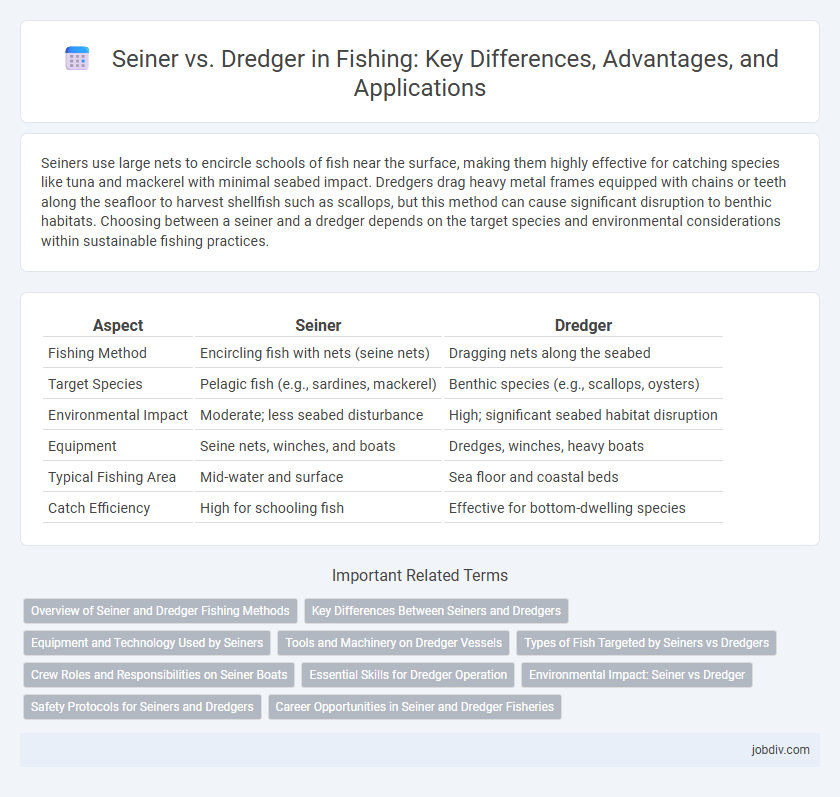Seiners use large nets to encircle schools of fish near the surface, making them highly effective for catching species like tuna and mackerel with minimal seabed impact. Dredgers drag heavy metal frames equipped with chains or teeth along the seafloor to harvest shellfish such as scallops, but this method can cause significant disruption to benthic habitats. Choosing between a seiner and a dredger depends on the target species and environmental considerations within sustainable fishing practices.
Table of Comparison
| Aspect | Seiner | Dredger |
|---|---|---|
| Fishing Method | Encircling fish with nets (seine nets) | Dragging nets along the seabed |
| Target Species | Pelagic fish (e.g., sardines, mackerel) | Benthic species (e.g., scallops, oysters) |
| Environmental Impact | Moderate; less seabed disturbance | High; significant seabed habitat disruption |
| Equipment | Seine nets, winches, and boats | Dredges, winches, heavy boats |
| Typical Fishing Area | Mid-water and surface | Sea floor and coastal beds |
| Catch Efficiency | High for schooling fish | Effective for bottom-dwelling species |
Overview of Seiner and Dredger Fishing Methods
Seiner fishing involves using a large net called a seine to encircle and capture schools of fish, primarily targeting species like tuna, sardines, and mackerel near the surface or midwater. Dredger fishing employs heavy metal-framed dredges dragged along the seabed to harvest shellfish such as scallops, oysters, and clams, impacting benthic habitats. Both methods differ significantly in technique, target species, and environmental impact, with seines focusing on pelagic fish and dredgers on benthic invertebrates.
Key Differences Between Seiners and Dredgers
Seiners utilize large nets called seines to encircle and capture schooling fish near the surface, enabling selective targeting and minimizing habitat disruption. Dredgers deploy heavy, metal-framed dredges dragged along the seabed to harvest benthic species like scallops and clams, often causing significant disturbance to marine substrates. The primary difference lies in their fishing methods and target species, with seiners operating primarily in pelagic zones and dredgers focused on demersal or benthic environments.
Equipment and Technology Used by Seiners
Seiners utilize specialized equipment such as purse seine nets designed to encircle and capture large schools of fish efficiently, often deploying hydraulic systems to operate the nets with precision. Advanced sonar and GPS technology enhance their ability to locate fish schools quickly, optimizing catch rates while minimizing fuel consumption. The integration of mechanized winches and skiffs further supports precise net deployment and retrieval, distinguishing seiner vessels technologically from dredger operations.
Tools and Machinery on Dredger Vessels
Dredger vessels utilize heavy-duty winches, drag arms, and powerful suction pumps to excavate and collect bottom sediments efficiently. These vessels are equipped with cutter heads or suction pipes that penetrate seabeds, enabling the extraction of fish habitats alongside sediment removal. Advanced hydraulic systems and onboard monitoring technologies optimize dredging operations, ensuring precision and minimizing environmental impact compared to traditional fishing methods.
Types of Fish Targeted by Seiners vs Dredgers
Seiners primarily target pelagic fish such as tuna, sardines, and mackerel, which swim near the surface or in midwater, making them suitable for encircling with nets. Dredgers, on the other hand, focus on benthic species like scallops, oysters, and clams found on or near the seafloor, using heavy metal-framed nets dragged along the bottom. The choice between seiner and dredger methods depends on the habitat and behavior of the targeted fish or shellfish species.
Crew Roles and Responsibilities on Seiner Boats
Seiner boats feature a crew specialized in deploying and retrieving large purse seine nets to encircle fish schools, with roles including the skiff operator managing the small boat for net setting, and deckhands handling net spreading and hauling. The captain oversees navigation and fish detection, while the engineer maintains onboard equipment essential for net operations. Each crew member's coordinated efforts maximize efficiency in capturing pelagic species like tuna and mackerel, differentiating the seiner's team structure from the dredger's primarily bottom-harvesting roles.
Essential Skills for Dredger Operation
Operating a dredger requires essential skills such as precise navigation to maneuver the vessel safely in shallow waters, effective management of hydraulic systems used to lift and deposit sediments, and expertise in monitoring equipment performance to prevent mechanical failures. Knowledge of seabed composition and environmental regulations ensures sustainable dredging practices that minimize ecological impact. Strong problem-solving abilities and teamwork coordination are critical for responding swiftly to operational challenges during dredging activities.
Environmental Impact: Seiner vs Dredger
Seiners use encircling nets to catch fish, causing minimal disruption to marine habitats and lower bycatch rates, which preserves biodiversity. Dredgers drag heavy metal frames along the seabed, destroying benthic ecosystems, increasing turbidity, and leading to significant habitat loss. The environmental footprint of seining is comparatively low, making it a more sustainable fishing method than dredging.
Safety Protocols for Seiners and Dredgers
Seiners follow strict safety protocols including regular vessel stability checks, mandatory life raft drills, and use of harnesses to prevent falls during net deployment and retrieval, minimizing risks in rough seas. Dredgers implement rigorous equipment maintenance routines, enforced exclusion zones around dredging sites, and continuous monitoring of underwater hazards to protect crew and vessel from mechanical failures and accidental collisions. Both fishing methods prioritize emergency communication systems and crew training to enhance onboard safety and ensure rapid response during incidents.
Career Opportunities in Seiner and Dredger Fisheries
Career opportunities in seiner fisheries often include roles such as deckhands, skippers, and fish processors, emphasizing skills in handling purse seine nets and fish sorting. Dredger fisheries offer positions like dredge operators, maintenance technicians, and marine biologists focused on shellfish harvesting and seabed conservation. Both sectors provide pathways for specialization but differ in equipment expertise and harvest targets.
Seiner vs Dredger Infographic

 jobdiv.com
jobdiv.com